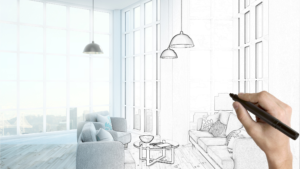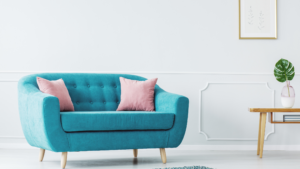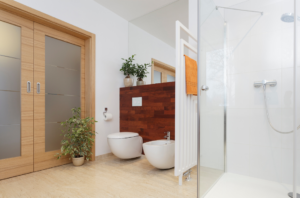Rita Wilkins's Blog, page 51
March 1, 2021
Top 10 Bathroom Design Trends to Avoid
By Rita Wilkins
The Downsizing Designer
Clients have been expressing how anxious they are to do something with their bathrooms since they have been sheltering in place for the past year. They are seeing and experiencing their homes with a new set of eyes. Things that may have bothered them before are now at the forefront, suddenly bothering them more than they ever had before. They are ready to do something about it… to make the changes they put off because:
They did not have enough time in their busy schedule.They did not take time to “see it” before.They promised they would get to it “someday”.The fact is, home remodeling has soared by 42% because of the pandemic. While you might be tempted to just “do it” (meaning a big renovation), I would like to caution you to slow down just a little so you aren’t tempted by the newest, hottest, and latest design trends.
At least first, consider if the current design trends are “right” for you. Below, find my list of the top 10 design trends to avoid… or to at least think twice about before you remodel.
Design is a fashion industry that introduces new and innovative things every day.
Yes, that’s exciting, but as a designer, I’ve learned to be discriminating and ask,
“is it right for you in the long term?”
After all, a bathroom renovation is expensive. It can easily cost $ 15,000 to $ 40,000 and up. $ 15,000 is the low range and $ 40,000 and above is the higher range. Before you are tempted to look at the newest design trends… ask yourself, “is it right for you?”
10 Top Design Trends to Avoid… or at Least to Think Twice About1. Oversized Tubs
While making a beautiful style statement, oversized tubs take up a lot of space or real-estate.
Ask yourself…
How often do you take baths?Is it worth the amount of real estate that it will take up in your bathroom or would you prefer to use this space for a large walk-in shower?How else can you use some of the footprints that would be utilized by an oversized tub?2. Floating Sinks
As beautiful as floating sinks might be to look at, consider how difficult they are to clean and maintain.
Ask yourself…
Am I willing to spend the extra time required to clean in and around the floating sinks?How practical is it for my current lifestyle?3. Double Sinks
While double sinks have become a standard in the industry and on paper they sound good because it is a great use of space, but…
Ask yourself…
How often are you both in the bathroom at the same time?How necessary is it to have two sinks or could one sink better serve your lifestyle?Would you rather have extra counter space by using only one sink versus two?Would you rather have “his” and “her” separate vanities as an alternative?

Free Download Step-by-Step Guide to Designing Your Dream Bathroom, click here.
4. Mosaic TilesWhile a beautiful design statement, when you use mosaic tiles, there is a considerable amount of cleaning due to an increased quantity of grout.
Ask yourself…
Is “the look” timeless enough or are you drawn to it because it is the current trend?Are you prepared to clean all of that grout regularly?Have you considered large oversized tiles that looked great and will have less grout?5. Wall Mounted Vanities
This design trend looks great. It’s clean-looking and streamlined, but…
Ask yourself…
Does it provide enough storage for your daily needs?Where will you plan on storing toilet paper and cleaning supplies?6. Integrating the Bedroom and Bathroom
This is a look that you might have recently seen in high-end hotels and magazines. Somewhat controversial, it blurs the lines between bedroom and bathroom, making it one seamless area.
Ask yourself…
Is this design right for your lifestyle now and will you continue to appreciate it long term?If you or your partner are messy, do you really want to see toothbrushes and make-up from your bed every morning or nighttime?7. Super Expensive Bath Fixtures
Because design is a fashion industry, designers are always coming up with new innovative designs that are sometimes very expensive.
Ask yourself…
Will this expensive fixture (i.e. toilets that play music and light up) at the cost of $ 7,000 to 10,000 thousand?Will this fit in your overall remodeling budget?8. Glass Countertops
While glass countertops pretty and contemporary looking, they are relatively impractical for daily use.
Ask yourself…
How much time do you want to spend cleaning glass countertops?Are you willing to deal with scratches to those surfaces?9. All Black Fixtures
This design trend is now back after many years, and while beautiful, it’s another one of those high maintenance selections.
Ask yourself…
How willing are you to spend time maintaining black fixtures?Is your partner willing to assist you with keeping it clean?10. The All White Bathroom
This is one of the hottest design trends today.
Ask yourself…
Will you grow tired of not having some color in your bathroom?Are you willing to spend the time that it will take to maintain an all-white bathroom?Design Trends That Are Expected to Last
1. Biophilic Design (letting the “outside-in”)
Biophilic designs allow us to blur the lines between the inside and the outside, connecting us with nature. It provides a sense of openness and freedom.
Examples:
Large windows allow us to experience nature from the inside.Skylights that led in natural light and provide a sense of dimension.2. The Use of Natural MaterialsMaterials such as stone, clay, and metal also connect us with nature.
3. Eco-Friendly Sustainable MaterialsThe trend of reclaimed woods, recycled materials, water-saving devices, plants, and green walls is likely to be with us for long term because it connects us with nature. It is also socially responsible and providing a sense of health, wellness, and positive energy.
Bottom line:
Before you start your next bathroom renovation, consider whether the current design trends are right for you… or not.
While you might be tempted to try the next “big thing”, ask yourself if you are being influenced because it is one of the newest design trends or if it is something that you should at least think twice about… or perhaps even avoid.
Do you need assistance with your bathroom design? I am happy to help.
Schedule your free 30-minute complimentary consult, here.
I also do online design consultations.

February 25, 2021
Bring on the Romance! How t
BY RITA WILKINS
THE DOWNSIZING DESIGNER
Have you ever wanted to make your master bedroom your own private refuge?
A place just for the two of you, a romantic getaway in your own home… not just for Valentine’s day or special birthday or anniversary, but for all year long.A room that the minute you walk in, it sets the mood for romance. It feels like a romantic retreat… warm and intimate that you and your partner look forward to sharing every day of the year.My Top 5 Tips on How to Design A Minimalist Master Bedroom Retreat That You’ll Love Year-Round
1. Pare down to the bare essentials
The best way to start is by declutteringClear your room of all distractions, all non-essentials. That includes, tv, media, or clutter of any kind. Remove excess photos from your nightstands, magazines, books, or any other items that you have collected.
Nix the clutter by paring down to just the bare essentials:Your bed, a dresser, nightstand or night table, seating, a dresser. Everything else should be put away in drawers or closets. By taking this minimalist approach your focus will be on each other not on all of the clutter.
Flirting with Minimalism or Downsizing? These TED Talks May Just Talk You Into It
2. Make your bed or bed wall the primary focus of the room
When you feature the bed, the headboard, the luxury linens, pillows and robes, it is an invitation to relax, unwind, or simply enjoy.
One inexpensive way to do this is to create an accent wall with a dramatic paint color. Whether it’d be a dark and dreamy palette, a soft and sensuous color scheme, or maybe even a spicy flirty color each should be an expression of your unique personality and taste.
When you layer the bed with soft textured linens, plush pillows, and a luxurious “statement headboard” that is often over-scaled, you invite romance in to your room.
3. Set the mood with romantic lighting
Layer your lighting with multiple types of lights:
A crystal chandelierPendant lights above the night tablesSconce lighting for soft accentsLamp lighting as neededCandle lightsNo matter what kind of lighting make sure to put dimmers on all of them for creating a romantic mood.
4. Create an intimate sitting area
The perfect loveseat with ottoman or pair of chairs angled in towards each other invites intimate conversations, snuggling, and sharing life’s most priceless moments. Use area rugs that are plush and extra soft to sit or lie down further enhance the experience.
5. Ignite your passions with those unexpected touches and flirty accents
If you want to design a minimalist retreat, don’t forget to arouse all of your senses in your new master bedroom retreat. Include sight, sound, smell, taste, and touch.
Create a minimalist room that is not only beautiful to look at, but it tastefully displays a photo or two of a special place or time you shared together. It can also playfully display flirty accent pieces that include pillows, artwork, or books.Surround yourself with soothing music, favorite songs that bring back great memories of times you had together.Include some of life’s simple pleasures… champagne, strawberries, and chocolate.Entice your partner with soft robes, fresh flowers, pillows, and plush rugs.
Why not create a minimalist master bedroom retreat that radiates romance year-round?
I’m sure that both you and your partner will be glad you did! If you need help designing or decluttering your own master bedroom retreat, I provide virtual design consultation. Take advantage of a FREE 30-minute phone consult with me. Click here.
 The post Bring on the Romance! How to Design a Minimalist Master Bedroom Retreat You’ll Love Year-Round first appeared on Design Services LTD.
The post Bring on the Romance! How to Design a Minimalist Master Bedroom Retreat You’ll Love Year-Round first appeared on Design Services LTD.
February 23, 2021
How Do Designers Keep Coming up With New Ideas?
By Rita Wilkins
The Downsizing Designer
Have you ever wondered how designers or any creative people are able to just keep coming up with fresh new ideas?
Me too! …. Just kidding!
But frankly, I never took the time to answer that question myself, until one day a client asked me “how do you just keep coming up with such great new ideas?”
As I was picking topics for my blog, I thought I would explore more on this question. If you are not particularly creative but would like to be, this article might help you.
When faced with a new project or challenge, I often hear myself saying these two things:
“I have no idea how to do this, but I will figure it out.”“I’ve never done or tried this before, but I’ll give it my best shot and learn from it.”4 Key Ingredients on How to Generating New Ideas1. MindsetBe open to new ideas and challenges.Be somewhat fearless, not knowing what the end game looks like, but still get excited to begin the journey.
My downsizing journey was an adventure in being completely open to what it would be like to live with 95% less, what it would be like to create a whole new lifestyle living with less. Was I afraid? Yes! Was the process messy? Yes! But the journey provided an outcome I could never have imagined before.
2. CuriosityLet your imagination run wild to envision what’s possible.
Be curious. Give yourself permission to step outside of your comfort zone and embrace life’s skinny branches.
3. Skill SetDevelop the ability to “see through walls”.
Having the ability to see things differently or to “see through walls” helps you penetrate barriers so you can make room for new ideas that you might never have thought of before.

Test your new ideas to see if they work or don’t work. Don’t get attached to one big idea until you have explored multiple options. In my design world, I always propose a minimum of three design solutions. I call this the magic of three. Before coming up with three good solutions, likely I would have explored at least 8-10 new ideas.
Develop the ability to solve problems and create innovative solutions.Learn how to connect the dots, what works and what doesn’t work, and continue to generate new ideas to solve the problem.
4. Ask Questions
Having a toolbox or a tool kit means asking a thousand questions. You have to understand the problem, get to know the client, and literally walk in their shoes to experience their pain or problem that they want and need to solve.
One particular design project comes to mind.
When I first walked into a new medical office project, my first observation and inquiry was “how can they possibly work at this small desk in such a busy medical practice?” That was the beginning of me feeling their pain that needed to be solved to make the office more functional and efficient. What followed, were multiple questions to uncover what was working and not working. Only then could I assist them in solving their design dilemma.
Design is a process!There is a beginning.There’s a messy middle.There is an end.The before and after pictures in our portfolio are always interesting because at the beginning you don’t always get to see the process and how we got to the final results. It is in that “messy middle” where… ideas are generated and solutions are created.
That’s what’s so much fun about the design process…It’s messy!It’s rarely pretty.It takes time.It’s iterative.It evolves and expands.Ultimately… it gets refined to one big beautiful solution. Where does inspiration come from?Look around. Learn to listen and observe.I often get inspired by watching people and listening to conversations.
The same is true with design.
Listen to what people complain about“This office chair is not comfortable… this sofa doesn’t fit me properly.”
Listen to what they want, need, and wish for.“A kitchen I can cook in and still be with my family and friends.”“A better layout for my home office, so I can be more productive.”“A walk-in shower that is not only beautiful but safe.”“A home that is safe for us as we age.”Be cognizant of the most creative time of your day.Use that energy to explore and ask questions. This is the perfect time of your day to create new ideas and solutions.
Ask questions, brainstorm, throw out new ideas.Gather colleagues and friends to listen to their ideas and solutions.
Experience nature.Get outside and give yourself time in nature to think, be inspired, and be curious.
Study other similar projects or designs.Study solutions that you like and discern how you could you apply these ideas in a creative new way.
Vision boards or mood boards.Let these creative tools inspire you to generate new ideas.
Wondering where to start?
Start today by challenging yourself to think like a designer.
Pick a problem area you want to work on.Generate multiple ideas and solutions.Engage in others in the process.And just have fun!This is a vital skillset that you can develop over time.
Test and try out your new ideas, learn to fail fast, and just have fun!
Need new ideas for an upcoming design project? I am happy to assist.
Schedule a 30-minute complimentary consult, click here.
Download your free “22 Steps to Upgrade Your Kitchen Design”, click here.

February 18, 2021
How Do You Know When It’s the Right Time to Downsize Your Home?
By Rita Wilkins
The Downsizing Designer
So much has changed in our lives and in our world in just one year. With so much uncertainty all around us, many of us just want to hold on to things that are familiar, giving us a sense of normalcy. That includes our homes, our jobs, and our possessions.
And yet, it is also a time that many people are seeing this as the perfect time to make changes in their lives that they have been thinking about for a long time.
It’s as if they are saying, everything else has changed, why not take this opportunity to do something or to make the changes they have been thinking about for a very long time… downsizing your home, changing careers, or starting a new business.
In some ways, the pandemic has motivated many people to say:
“Just go for it!”“It’s now or never!”“If not now, when?”My sister and brother-in-law are a perfect example. They had been thinking about downsizing from their larger home so they can move closer to their daughter and son-in-law. They seized the opportunity to “just do it” and are now settled in their new home just a few miles from their family.
Their thoughts were…
“Let’s live our lives without regret. We never know what tomorrow might bring.”“Let’s do it while we are young enough to enjoy it.”“Let’s transition while we can both continue to work from anywhere.”If you are asking yourself any of these questions…
“How do I know if it’s the right time to downsize my home?”“Should I stay or should I go?”This blog is intended to help you answer that question.
As The Downsizing Designer, I’m asked these questions all of the time.
Questions to Ask Yourself to Know if and When Is the Right Time to Downsize Your HomeI. Assess your current home and living situation Is your home affordable for you?
A Harvard study says approximately 39 million Americans cannot comfortably afford their home and another 19 million are spending at least half of their income on housing. If you are spending more than you can reasonably afford, it may be time for you to reevaluate if you should stay or go.
Is your home livable for you right now at this stage of your life? Does it satisfy your current and future needs?Is it age-appropriate?According to AARP, 90% of Americans prefer to stay in their own home as they age, but the question becomes, is it too big for you right now? If your kids are grown and have gone from your nest, people typically only use four rooms of their house. While your home may have been perfect at one time of your life, ask yourself is it still the right home for you now at this stage of your life?
Do you have unused areas like bedrooms and bathrooms?How are you using your attic, basement, and garage?Has your home become a storage place for your kids’ belongings, or for items that you have inherited or accumulated over a long period of time?
Begin to weigh the cost of unused or under-utilized spaces that are costing you money that you could better use on other things that matter to you like travel or learning.
Bottom line: is it cost-effective to stay in your large home at this stage of your life?

Download your free “ABC’s of Downsizing”. Click here.
Is your home navigable and accessible? Are areas of your home becoming more difficult for you to navigate, i.e. stairs?Will your two or three-story home be suitable for you as you age?Is your soaking tub hard to get in and out of, causing a possible tripping hazard?I. Assess your current life season, life stage, and life circumstances. Your Life Season
Are you saying any of the following things to yourself or to your significant other?
“It’s the right time to let go”“It’s the right time for us to have a new life.”“It just makes sense to downsize to a smaller more affordable, more functional space.”“I am ready for a simpler life, to begin a new chapter.”“I want to be closer to my children and grandchildren.”“I don’t want to grow old alone in my big house.”Your Life StageEmpty nest: your kids are grown, they are on their own, and it’s time for YOU.Retirement or pre-retirement: where do you want to live, what kind of lifestyle do you want?Elderhood: do you want to live closer to your family or in a community that will help care for you as you age?Your Life CircumstancesYou have recently divorced.Your partner or spouse has died.You have experienced a job loss or financial hardship.You have become a caregiver.
Bottom line: if you are thinking of downsizing your home, here are some steps that you can take:
Assess your current home for affordability, livability, usability, and accessibility.Assess your life season, it’s time, it makes sense, or you are ready for a change.Assess your life stage empty nest, retirement, or preretirement, or aging.Assess your life circumstances, divorce, death of a spouse, financial hardship, or new caregiving status.
If You Are Ready to Downsize Your Home, but Don’t Know Where to Start
You can refer to my previous post, You Are Thinking About Downsizing Your Home, but You Have No Idea Where to Start, where I talk about steps you can take to help you begin your downsizing journey.
Did you know that we offer a full range of downsizing services? Schedule your 30-minute complimentary call, click here.

The post How Do You Know When It’s the Right Time to Downsize Your Home? first appeared on Design Services LTD.
How Do You Known When It’s the Right Time to Downsize Your Home?
By Rita Wilkins
The Downsizing Designer
So much has changed in our lives and in our world in just one year. With so much uncertainty all around us, many of us just want to hold on to things that are familiar, giving us a sense of normalcy. That includes our homes, our jobs, and our possessions.
And yet, it is also a time that many people are seeing this as the perfect time to make changes in their lives that they have been thinking about for a long time.
It’s as if they are saying, everything else has changed, why not take this opportunity to do something or to make the changes they have been thinking about for a very long time… downsizing your home, changing careers, or starting a new business.
In some ways, the pandemic has motivated many people to say:
“Just go for it!”“It’s now or never!”“If not now, when?”My sister and brother-in-law are a perfect example. They had been thinking about downsizing from their larger home so they can move closer to their daughter and son-in-law. They seized the opportunity to “just do it” and are now settled in their new home just a few miles from their family.
Their thoughts were…
“Let’s live our lives without regret. We never know what tomorrow might bring.”“Let’s do it while we are young enough to enjoy it.”“Let’s transition while we can both continue to work from anywhere.”If you are asking yourself any of these questions…
“How do I know if it’s the right time to downsize my home?”“Should I stay or should I go?”This blog is intended to help you answer that question.
As The Downsizing Designer, I’m asked these questions all of the time.
Questions to Ask Yourself to Know if and When Is the Right Time to Downsize Your HomeI. Assess your current home and living situation Is your home affordable for you?
A Harvard study says approximately 39 million Americans cannot comfortably afford their home and another 19 million are spending at least half of their income on housing. If you are spending more than you can reasonably afford, it may be time for you to reevaluate if you should stay or go.
Is your home livable for you right now at this stage of your life? Does it satisfy your current and future needs?Is it age-appropriate?According to AARP, 90% of Americans prefer to stay in their own home as they age, but the question becomes, is it too big for you right now? If your kids are grown and have gone from your nest, people typically only use four rooms of their house. While your home may have been perfect at one time of your life, ask yourself is it still the right home for you now at this stage of your life?
Do you have unused areas like bedrooms and bathrooms?How are you using your attic, basement, and garage?Has your home become a storage place for your kids’ belongings, or for items that you have inherited or accumulated over a long period of time?
Begin to weigh the cost of unused or under-utilized spaces that are costing you money that you could better use on other things that matter to you like travel or learning.
Bottom line: is it cost-effective to stay in your large home at this stage of your life?

Download your free “ABC’s of Downsizing”. Click here.
Is your home navigable and accessible? Are areas of your home becoming more difficult for you to navigate, i.e. stairs?Will your two or three-story home be suitable for you as you age?Is your soaking tub hard to get in and out of, causing a possible tripping hazard?I. Assess your current life season, life stage, and life circumstances. Your Life Season
Are you saying any of the following things to yourself or to your significant other?
“It’s the right time to let go”“It’s the right time for us to have a new life.”“It just makes sense to downsize to a smaller more affordable, more functional space.”“I am ready for a simpler life, to begin a new chapter.”“I want to be closer to my children and grandchildren.”“I don’t want to grow old alone in my big house.”Your Life StageEmpty nest: your kids are grown, they are on their own, and it’s time for YOU.Retirement or pre-retirement: where do you want to live, what kind of lifestyle do you want?Elderhood: do you want to live closer to your family or in a community that will help care for you as you age?Your Life CircumstancesYou have recently divorced.Your partner or spouse has died.You have experienced a job loss or financial hardship.You have become a caregiver.
Bottom line: if you are thinking of downsizing your home, here are some steps that you can take:
Assess your current home for affordability, livability, usability, and accessibility.Assess your life season, it’s time, it makes sense, or you are ready for a change.Assess your life stage empty nest, retirement, or preretirement, or aging.Assess your life circumstances, divorce, death of a spouse, financial hardship, or new caregiving status.
If You Are Ready to Downsize Your Home, but Don’t Know Where to Start
You can refer to my previous post, You Are Thinking About Downsizing Your Home, but You Have No Idea Where to Start, where I talk about steps you can take to help you begin your downsizing journey.
Did you know that we offer a full range of downsizing services? Schedule your 30-minute complimentary call, click here.

The post How Do You Known When It’s the Right Time to Downsize Your Home? first appeared on Design Services LTD.
February 17, 2021
What Is Lean Design? Lessons I’ve Learned by Living With 95% Less
By Rita Wilkins
The Downsizing Designer
More is not necessarily better… even in interior design.
Our culture would like us to believe that…
More is better than less.Bigger is better than small.So we buy bigger houses and fill them with more stuff.
As beautiful as that all might sound, just ask yourself this question
“When is enough just enough?”
As a designer for over 35 years, I’ve lived in a world with a lot of beautiful stuff. Four years ago, I downsized from my big beautiful designer home filled with well-curated designer items to my tiny jewel box apartment where I now live on 5 % of what I once owned. After downsizing, I realized how much happier I am living with less because it has led me to a much richer, more abundant life where I appreciate what I have more.
I now have more time, money, and energy to pursue other things that matter to me. What I personally discovered and what I now share in my book, “Downsize Your Life, Upgrade Your Lifestyle: Secrets to More Time, Money, and Freedom” is that living with less allows you to live more, in other words, it allows you to have more life.
How You Can Experiment With Lean Design Yourself
1. Pick one room in your home that you wish was simpler, less cluttered, and more peaceful
This room might be a room that is not working for you and you may not understand why.
An example may be your home office. Imagine this room to be a room that you will love, a room that’s peaceful, and makes you happy just to be in it. It is a room that when you are in it, you are highly productive.
2. Identify the purpose you want for that room.How do you want it to function or work for you?What do you want it to look like?How you want to feel when you are in that room?
Examples might be your master bedroom, your home office, or your guest room.

Look closely at each area of that room… the furniture, the space plan, the color palette, the natural lighting and the ambient lighting. Ask yourself, what is working? what’s not working? how does this room make you feel when you are using it?
4. Choose to keep only what you love in that room.
Select only items that you value, that matter to you and make you happy.
(i.e. particular photos, a piece of artwork, a funny pillow, or a unique area rug.)
This is a different take on decluttering. We are often more concerned about what to get rid of when we should actually be more concerned with what to keep.
When you surround yourself with only the things you love… the room then reflects who you are and what matters most to you.
5. Next, edit the remaining things in the room.
Edit any remaining items that don’t matter to you. By removing things that don’t matter and keeping things that do matter, you are now planning a room that is not only highly functional but it also makes you happy, it invites calm, serenity, and productivity.
That is the essence of what lean design is.
It’s pairing down to only the thing that matter to you.It’s intentional design.It creates a pathway to designing the life you really want and one that works for you.It’s getting rid of what you don’t want so you can make room for what you do want.It helps you let go, to live a simpler, less cluttered life, so you just have just enough … one room at a time.Try this exercise at home. Let me know what difference it makes in creating rooms that you love.
If you need help in decluttering, I offer a “6-Week Decluttering” course, click here.
Grab a copy of my book that is available at Amazon, click here.
Lean design is…
having a clear vision and purpose for each room.
knowing what you want, need, and wish for in that room.
editing what you don’t want out of the room.
This will allow you to focus your attention on what matters most to you and what you value.

Comment in the comment section below.
The post What Is Lean Design? Lessons I’ve Learned by Living With 95% Less first appeared on Design Services LTD.February 8, 2021
Do You Like Saving Money? Top 10 Ways to Save Money on Your Bathroom Renovation
By Rita Wilkins
The Downsizing Designer
If you’re like most of us today, we’re all looking for ways to save money, and yet you know your bathroom is in desperate need of updating and remodeling. That’s why I want to share with you a few of my top ways to save money on your renovation without sacrificing the quality or the look.
Yes, it is possible to have a highly functional bathroom
and have it look beautiful
and have it fit into a realistic budget.
In other words, you can have it all, and here’s how.
Top 10 Ways to Save Money on Your Bathroom Renovation
Keep plumbing where it is.
This is one of the easiest ways to save money and one of the most obvious. Relocating plumbing for toilet, sink, shower/tub can be labor intensive and significantly add to the overall cost and time.
If this works, then try to design around your current plumbing locations.
One caveat: never sacrifice a better space plan and layout in lieu of relocating plumbing. That’s why, as a designer, I always explore multiple space plan options during the design process. We might offer two or three designs, reusing existing plumbing locations and then explore other space plans where plumbing is relocated.
Stay within the footprint of the existing space (within the existing walls).
Design within the walls if the overall size of your current bathroom is adequate and if there are no better alternatives to expanding the size of your bathroom.
If you want to save money and time, it’s best to stay within your existing footprint.
Carefully monitor your finish and fixture selections.
This is one area people sometimes go on rogue and blow their own budget! When working with a client who is on a budget, it’s often me, the designer, that has to hold them back from overspending! The beautiful finishes and fixtures can be tempting, but if you want to stay on budget…
Select from stock finishes and fixtures.You often get better pricing (i.e. tile). Try to stay away from special order and custom, if possible.
Select from overruns and cut pieces.Look for granite slabs that are cut pieces, they might just suit your needs perfectly.

Know what you want and don’t want, what you will use and won’t use.
How often do you actually use your current tub? If your answer is not that often, consider utilizing that footprint to design a really nice walk-in shower.
This is a lifestyle question because some people do use their tub often. But if you are prone to taking more showers, why not make better use of the space with a large shower? At the same time, save money on not having the cost of a tub, providing more space and more room in your budget.
Paint vs tile.
Using paint in selected areas versus tile will significantly reduce your budget while still having a great impact. Also, using tile strategically can also save budget (less material, less labor, reduces costs).
Consider alternatives to tile.
The classic bead board is a great look, less expensive to buy and to install, but it is also a little harder to maintain if your bath is heavily used.
Other choices: vinyl wallcovering, paint, and faux finishes.
Replace the toilet lid and seat instead of purchasing a new toilet.
If your toilet is still in good condition, give it a fresh look with a new lid and seat. This will save the cost of a new toilet and the plumbing labor.
Select a more basic toilet.
Ask if you really need a seat warmer, music, and a night light on your toilet. Yes, there are amazing toilets that have these more exotic options. We have used them numerous times in luxury bathrooms at the cost of seven to ten thousand dollars each, but if you are interested in saving money on your bath remodel, I would suggest you look for good quality and more cost-effective options.
Bathtubs or soaking tubs.
The same is true for bathtubs/soaking tubs. There are some pretty amazing features you can get in a tub, but ask yourself where you want to save money. This is something to consider because if the tub is of great importance to you, then you might decide to spend money on a fabulous tub and cut your budget elsewhere. This is a lifestyle choice.
Knowledge is the most powerful tool to save money.
Understanding the cost of materials, labor, construction methods, construction process, and the design process, will help you save time and money.
One of the best tips I can offer is to spend money upfront by:
Hiring a professional interior designer or architect to help you design the best plan that will work within your budget.Having a final plan before you start is not only money well spent, but it will help you avoid costly errors. It will also help you get the design you really want while also helping you stay within your budget.As you can see, there are many ways to save money and have a great bath that suits your wants and needs. I hope that these top 10 ways to save money on your bath renovation will help you realize you don’t have to spend a great fortune to have a great bath.
If you want to know more about our interior design services, go to the website and schedule a complimentary 30- minute call, click here.
Also, if you are interested in learning more, download my free “Step-by-Step Guide to Designing Your Dream Bathroom”, click here.

Comment in the comment section below.
The post Do You Like Saving Money? Top 10 Ways to Save Money on Your Bathroom Renovation first appeared on Design Services LTD.February 4, 2021
If You are Remodeling Your Bathroom Why Not Future-Proof It?
By Rita Wilkins
The Downsizing Designer
Face it, renovations of any kind costs a lot of money, so if you are investing in a remodel, why not design it so that it works for everyone and that it’s ageless?
What I mean by that is…
If you incorporate universal design principles in your bathroom renovation, you can make it comfortable, safe, and accessible for everyone in your family regardless of age or ability. By planning for potential future needs (wheelchairs, walkers), as well as your current needs.And the good news is that with such a great array of products and finishes today, it is easier than ever to create a bathroom that is not only beautiful but also functional and safe.
There are three terms that you’ve probably heard of:
Universal designAccessible designAging in placeAll three terms have similar goals: to make your bathroom easy to navigate, safe, and efficient for all regardless of age or ability.
Integrating universal design principles in to your design is smart, because in addition to providing for your current and future needs, it also adds to your home value.
8 Universal Design Elements to Add to Your Bathroom Remodel1. Curb less or barrier-free showersHave little or no transition/curb entering into the shower.Allows those with physical limitations to enter and exit easily (i.e., walker).A linear drain allows water to drain properly.A shower seat inside the shower provides comfort and stability.
2. Comfort height toilets or wall hanging toilets19 inches off the finish floor makes it easier to get up and down.
3. Grab bars
This may sound clinical, but you’d be surprised at the beautiful selections that are now available. Even if you don’t think you want or need grab bars now, I suggest you prepare with proper blocking/bracing inside of the walls for future installation.
Assist with balance as you get up, lower yourself into the shower or onto the toilet.Grab bars can also function as towel bars.4. Slip resistant flooringTexture creates friction and helps to prevent slips, making it safer for walking.
5. StorageReachable if sitting in a wheelchair at 32 inches off the finish floor.Open shelving with baskets or drawer storage is a possible option.

6. Wall mounted sinks and vanitiesMount 32 inches off of the finish floor to allow wheelchair access to roll under.Barrier to be placed around the plumbing to protect from hot pipes.
7. Faucets and fixturesLevers are easier than knobs.Sink faucets: automatic or touch-activated sink faucets.Shower: handheld shower with bar to raise and lower from sitting to standing position for reachability.Anti-scald temperature volume control.
8. Wider entry doors and entry way into bathroomHallway minimum: 36 inches.Door minimum: 32 inches.Door swings to outside not in.
It is possible to seamlessly incorporate universal design to make your bathroom functional, safe, and beautiful that will meet the needs of all family members regardless the age or ability.
If remodeling, why not future-proof your bath while you’re at it? It just makes sense.
I hope that these tips on universal design help you in making your bathroom ageless.
If you want to learn more about bath design, go to my website and download the FREE
Step by Step Guide to Designing your Dream Bathroom.
Share this blog with your friends and reach out to me on our website.
The post If You are Remodeling Your Bathroom Why Not Future-Proof It? first appeared on Design Services LTD.The Benefits of Living in a Smaller Home
By Rita Wilkins
The Downsizing Designer
If you’ve been living in your large home for a while, but lately you’ve started to say… It’s just becoming “too much”. Too much time, maintenance, and expense.
Perhaps you’ve been talking to some of your family or friends who have already downsized and they keep saying how much easier their lives are without the big house.
Perhaps they’ve got you thinking, “Should you downsize to a smaller home too?”
For sure, the large home served you well for many years while you were raising your family, and after all, you’ve worked hard for it, you deserved the big house, your dream house.
But lately you’re not so sure it is your dream house anymore. In fact, it might be becoming a nightmare.
Lately you’ve been asking yourself if you need or even want all of this at the stage of your life.
You’re wondering if you might be happier in a smaller, more manageable home.
One that is easier to maintain.One that is more affordable.One that gives you more time and freedom to have a simpler, less stressful life.If that sounds like you, you’re not alone. Many baby boomers and even younger generations are questioning the need and desire for “the big house” that they once aspired to and here’s why:
Benefits of Living in a Smaller Home1. More life
Living in a smaller home means there’s less to maintain, less to manage. It frees you up to do other things you’ve been wanting to do, but had to keep putting them on the back burner because you didn’t have time or energy to do them
Have you ‘ve been wondering what it would be like to have more free time to:
Develop that new side gig you’ve been thinking about?Start painting once again or learning how to play a new instrument?Or maybe just having free time to do nothing.A smaller home gives you back some of that time you’ve been missing.
2.Less stuffDownsizing to a smaller home forces you to address the stuff that you’ve been accumulating and saving for years.
The overflowing closets filled with clothes that may no longer fit you or that you might rarely wear.The unopen boxes in your basement or attic that you have no idea what’s even inside.The family heirlooms you inherited that you have been saving for your kids… only to find out that your kids have no interest in them or that they have no space in their own smaller homes.While emotional and exhausting, the process of downsizing and decluttering, the journey to owning less stuff is actually a journey to having more freedom.
3. Just enoughHow will you know when you have “just enough”?
This might sound like an existential question but it’s not intended to be.
Getting to having “just enough” is a journey. A journey well worth the time, the effort, and the emotional rollercoaster. When you arrive at a point in your life where you have all you want and all you need there is a new kind of peace, freedom, and joy. You are no longer striving to accumulate more, prove your success, or impress others. You are simply content because you have enough. Our consumer culture has programmed us to believe “bigger is better” but when you…
Our consumer culture has programmed us to believe “bigger is better” but when you…
You begin to realize that there is so much more to life when you live with less. You create the opportunity to live more.
I hope that this has provided some food for thought about living in a smaller home.
If you want to learn more, CLICK HERE to purchase my Amazon #1 Best Selling book, Downsize Your Life, Upgrade Your Lifestyle: Secrets to more Time, Money, and Freedom.
Share this blog with your friends and reach out to me on our website.
The post The Benefits of Living in a Smaller Home first appeared on Design Services LTD.February 2, 2021
How to Let Go of Sentimental Stuff
By Rita Wilkins
The Downsizing Designer
If you are trying to downsize or declutter your home, you might have difficulty with letting go of sentimental items.
You want to let go because you know you can’t keep everything, but it’s killing you to give up certain items.
You’re stuck.You’re frustrated, stressed, and overwhelmed.You’re feeling guilty about letting it go.On some level, you might even realize that holding on to these things is preventing you from moving on with your life. It’s holding you back, it’s an emotional roadblock.
Understanding that clutter of any kind, even sentimental clutter is simply deferring a decision to another time.
“I’ll get around it someday.”“When x happens, I’ll get rid of it.”“I will be ready to give to give it up someday.”But if you are trying to downsize and declutter now, you are being forced to make decisions. You are now being faced with how to let go of those sentimental things that you have been holding on to perhaps for a very long time.

Top 4 Reasons We Have Difficulty Letting Go1. Sentimental AttachmentThey are reminders of specific people, places, times, and events in our lives.They bring back good or bad memories.2. Security They make us feel safe and secure. And since security is a basic human need, there’s no wonder that we hold on to certain things. Sometimes we hold on to them because they make us feel safe, secure, and remind us of a time in our lives where we were specially cared for and protected.3. ScarcityThe fear of being without, not having enough can have us hold on to our things.Feeling that you spent “good money “on something or that you worked hard to get it, we think we would be wasting it if we get rid of it.Knowing our parents worked hard and saved money to buy a particular piece of furniture or set of silver or china, often prevents us from letting go.

How to Get Past Reasons for Holding On
Steps that you can take now!
Look at one item you’re having a particularly hard time letting go of and ask yourself these questions.
What good memories do you have of this item?What bad memories do you have about it?What emotions do they bring up?Maybe feeling of sadness, anger, happiness, and upset?Acknowledge that this item is making you live in the past.It’s making you look back and not forward. It’s making you hold on to those good or bad memories.If an item elicits bad memories…Ask if you are ready and willing to let go of the bad memories, to put them in the past so you can move on. An example would be to burn a photo or a letter that brings back those bad memories. This is not only cathartic but is also liberating.If the item brings back good memories…Take a photo of it, write a story about it, and let it go. Create a Shutterfly album of all the wonderful memories and stories. These are not only for yourself but for your future generations.Other Ideas to Help You Let GoIf you have multiples of a collection, keep just one of them. Take pictures of the rest, let go of them, and put the photos in a Shutterfly album.If you have family photos, sort through, digitize them. Legacybox.com is a valuable service that helps you consolidate and commemorate these photos.If you have kids’ trophies, school books, and other items that you have been holding on to for sentimental reasons, ask your kids if they really want to keep these? They might actually ask you why you are still holding onto their high school things when they are now adults.
Hopefully, you can even laugh at yourself for holding on to some of the things that you’ve kept for many years, the things you allowed to take up valuable space not only at your home but also in your mind and heart.
Now that you are downsizing and decluttering, you realize…
It’s time to stop resisting.It’s time to make decisions.It’s time to live with less so you can live more.I hope that this blog article helps you let go of sentimental items that have taken up space in your home and in your heart, so you can make room for a new less cluttered life.
If you are interested in learning more, register for my “6-Week Decluttering Challenge”, click here, sign up on the website, it’s only $ 30.

Comment in the comment section below.
The post How to Let Go of Sentimental Stuff first appeared on Design Services LTD.


